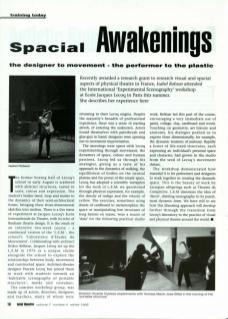The former boxing hall of Lecoq's school in early August is scattered with abstract structures, varied in scale, colour and expression. The student's bodies bend, loop and stutter to the dynamics of their semi-architectural forms, bringing these three-dimensional sketches into motion. There is a live sense of experiment at Jacques Lecoq's École Internationale de Théâtre, with its echo of Bauhaus theatre design. It is the result of an intensive two-week course – a condensed version of the LEM, the school's 'Laboratoire d'Etudes du Mouvement'. Collaborating with architect Krikor Belkian, Jacques Lecoq set up the LEM in 1976 as a unique studio alongside the school to explore the relationship between body, movement and constructed space. Architect-theatre designer Pascale Lecoq has joined them to work with students towards a 'habitable scenography of portable structures', masks and costumes.
The summer workshop group was made up of actors, directors, designers and teachers, many of whom were returning to their Lecoq origins. Despite the majority's breadth of professional experience, there was a sense of starting afresh, of entering the unknown. Actors found themselves with paintbrush and glue-gun in hand; designers were opening out to movement improvisation.
The mornings were spent with Lecoq experimenting, through movement, with the dynamics of space, colour and human passions. Lecoq led us through his analogies, giving us a taste of his approach to the dynamics of walking, the equilibrium of bodies on the neutral plateau, and the power of the empty space. Lecoq has adopted a scientific metaphor for the work of LEM: we questioned through physical expression, for example, the density of indigo and the velocity of yellow. The exercises, sometimes using sheets of cardboard to metamorphose the space or manipulating free structures of long batons en masse, were a source of 'data' for the following practical studio work. Belkian led this part of the course, encouraging a very immediate use of paint, collage, clay, cardboard and wood. Touching on geometry, art history and anatomy, his dialogue pushed us to express three dimensionally; for example, the dynamic tensions of jealousy. Rapidly a forest of life-sized structures, each expressing an individual's personal space and character, had grown in the studio from the seed of Lecoq's movement classes.
The workshop demonstrated how essential it is for performers and designers to work together in creating the dramatic space. This is the beauty of work by Lecoqian offsprings such as Theatre de Complicite. LEM dismisses the idea of 'decor', distilling scenography to its purest, most dynamic form. We have still to see how this liberating approach will develop further through the transition from Lecoq's laboratory to the practice of visual and physical theatre around the world.

